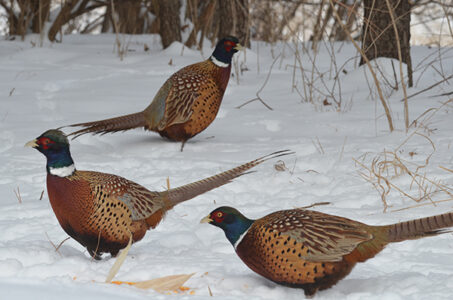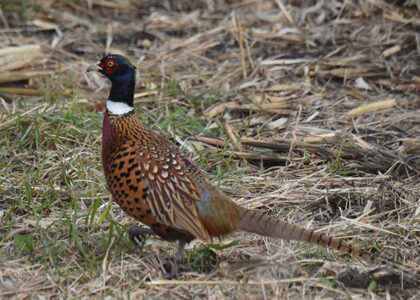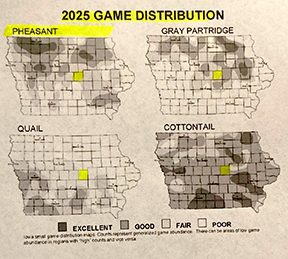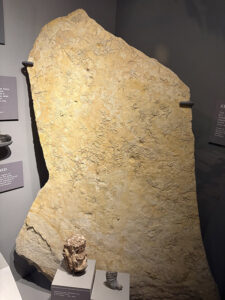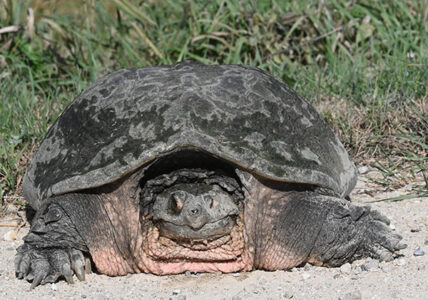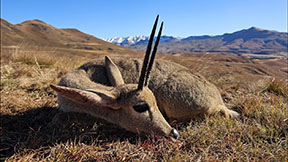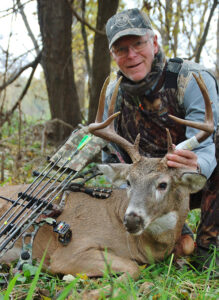Pheasant forecast shows good numbers
PHEASANTS are a huge deal for Iowa upland bird hunters. This year marks the 100th anniversary of pheasant hunting in Iowa.
It is one case of an introduced species from Asia that adapted very well to its release in 1925 across much of the United States. Many states jumped on the bandwagon to raise pheasants for stocking. From Oregon’s Willamette Valley to Montana, the Dakotas, Nebraska, Minnesota, Kansas and Iowa, plus many more states, pheasants found the agricultural landscape and small grain crops to be an ideal food factory, and the vegetation of grassland dominated states fit perfectly with the pheasant’s needs to nest.
Pheasants Forever and Quail Forever, Inc. is a private non-profit conservation organization. Members across North America are dedicated to this hunting sport and the conservation of the habitats upland birds require. An entire industry of conservation minded members supports
efforts to save, conserve and enhance wild places where upland game birds can thrive. Sporting dogs well trained to find and retrieve birds is just one aspect of having good pheasant numbers in the USA. Clothing specifically tailored for the needs of hunters busting through tall grasses or brushy cover is another.
In addition, shotguns from .410, 28, 20, 16 and 12 gauge, in a wide variety of singles, automatics, pumps, over/unders, or side by sides have been built to satisfy the diverse preferences of game bird hunters. Ammunition types for shot shells have also kept pace with modern day ballistics, non-toxic shot materials, and cookbook recipes of how to make delicious dishes of wild bird meat are almost too numerous to count.
Pheasant hunting also adds big numbers to the flow of money into the economy related to investments in equipment, dogs, vehicles, camper trailers, hotel reservations, fuel purchases and restaurant visits when visiting small towns across the interior of the USA. Small cities in the
middle of “nowhere” look forward to the economic bump pheasant hunting provides.
Some high end outfitters even have invested in lodges to host hunters, their dogs and have grand well designed and appointed log cabin facilities for overnight accommodations. Whatever fits your hunting preferences, ring-neck pheasants can and do inspire a wide range of services specifically because of the conservation work of fish and game departments, private land owners, and conservation organizations like Pheasants Forever.
In Iowa this fall, Todd Bogenschutz, who is the upland wildlife research biologist, noted that a statewide average of 28 birds per survey route is the highest since 2005. Regionally, this works out to good pheasant numbers in northwest Iowa.
Even in northeast Iowa, route numbers are the highest since 1998, and in other areas of Iowa, good increases can be found. A close look at the index maps for upland game will show areas of good, fair or poor numbers. The changes in distribution is largely a function of habitat types in a particular region, the amount of spring rains received, and last winter’s snow cover.
In Marshall County, public grassland habitats are looking good to great. The new Mann Wetland area south of Albion is showing very good growth of grasses and forbs planted there several years ago. It was mowed last year several times and again this year, finishing before a series of high water events curtailed mowing. Mowing is a land and vegetation management tool to help cut down the height of initial plantings.
The primary reason is sunlight access to the newly emerging prairie plants. Now in early September, the growth of the desired prairie grasses is looking fantastic. Other upland prairie sites to find pheasants include the Marietta Sand Prairie, Stanley Mill Mitigation Area, Arney Bend Wildlife Area, Iowa River Wildlife Area and Klauenberg Prairie Preserve.
There are also numerous grasslands owned and managed by private land owners that may hold pheasants. Pre-season scouting and contact with landowners is always a good thing.
Private land holdings will always vastly out number public land acres. Pheasants will go to wherever the habitat provides them the best cover and food.
A hunter may obtain a hard card, a credit card sized piece of plastic, that is printed with the Iowa Pheasants Forever Print of the Year, and listing the hunting privileges the hunter has purchased for 2025-26. This is an easy item to show to conservation officers who will be out and about this fall to check on compliance with state laws.
Iowa pheasant season begins Oct. 25 and goes through Jan. 10, 2026. Youth get a two day early taste of ringnecks the weekend prior on Oct. 18-19. This is for youth who are Iowa residents, and they must be age 15 or less. Good luck this fall as your pursuit of pheasants.
———
SEPTEMBER is a new month, just nine months past the start of 2025. Wow, time moves fast. From a natural history perspective, our summer of July and August did live up to our reputation of having some very warm to hot days.
It all averaged out so that nothing abnormal happened in the way of daily weather events. We just had to adapt and cope with reality.
Stay hydrated and seek cool air indoors. Outdoor adventurous folks found a breezy place to sit under the shade of a tree with a fishing line and lure in the water.
My unofficial rain gauge in Albion recorded August rains of 2.87 inches. By comparison, July rains had a much bigger total of 11.91 inches.
So far for the year 2025, my data shows rains since March tallying 26.81 inches. Any total rains of 32 inches will be typical for a growing season.
Historical information for September on the natural history ‘scoreboard’ shows that in our past, earthquakes big enough to be felt in Iowa happened on Sept. 3, 2016. It registered 5.6 on the intensity scale from a quake in another state.
Way back in 1909 on Sept. 27, another earthquake was felt in eastern Iowa. A note about these quakes is that very low intensity earth shaking of its bed rock layers many miles below the surface are not felt by humans. They are detected by sensitive instruments designed to keep track of earth’s internal rock slippages.
Another point about scaling of quakes, all the numbers mean is a way to put into perspective their power released. A quake of five is 10 times more intense than a four. A six is 10 times greater than a five. A seven is 10 times greater than a 6 and so on. Seven, eight and nine earthquakes are big indeed and likely depending upon the focus, likely to cause a lot of infrastructure damage to populated areas.
Iowa’s September will see beautiful monarch butterflies congregating and moving south toward Mexico. I mentioned in the photo cutline above that snow fell in western Iowa on Sept. 16,1881. The flip side of air temperatures tell us of Sept. 28,1953, when we experienced 103 degrees fahrenheit in Glenwood.
As for rain potential, a one day record of 21.7 inches fell near Boyden. A killing frost in northern Iowa is entirely possible and typical on or about Sept. 23.
The orbits of Earth and Saturn will be about as close as they will come to each other on Sept. 21. If the night sky is clear, a good pair of binoculars may allow you to see Saturn and its rocky rings.
Sept. 22 is the first day of the fall season — 12 hours of daylight and 12 hours of darkness. On Sept. 1, day length was 13 hours and 9 minutes for us at 42.0626 North latitude. On the 30th, day length will have shortened considerably to 11 hours and 49 minutes.
———
BIRD MIGRATION can be detected on Doppler radar. It is well known that many birds that have fed and rested during the day, will take off at sunset for an all night flight further south.
Doppler radar screen watchers at weather stations, if they know what they are seeing, will know the special blobs of greenish colors to be birds taking off in swarms. Doppler radar sends out radio waves that bounce off objects.
Normally rain drops are detected as well as aircraft, but the Doppler also can and does record insect flights, birds, bats, and butterflies. Experienced Doppler watchers know what to watch for, and what to disregard, but all the signals are still available to see and take due diligent note of. To learn more about internet websites that anyone can look at, try this one — woodcreeper.com. Tips on what to see are given by David A. LaPuma, director of the Cape May Bird Observatory. For instance, he notes that birds typically fly about 18 to 25 mph faster than prevailing winds (usually a tail wind).
Using radar to track movement of birds, bats and insects is not new. Researchers learned during WWII that birds and other critters could be observed by radar.
———-
“Nature is often hidden; sometimes overcome;
seldom extinguished.”
— Francis Bacon,
“Of Nature in Men””
————–
Garry Brandenburg is the retired director of the Marshall County Conservation Board. He is a graduate of Iowa State University with a BS degree in Fish & Wildlife Biology.
Contact him at:
P.O. Box 96
Albion, IA 50005
- PHOTOS BY GARRY BRANDENBURG Hunting season for ring-necked pheasants begins Oct. 25, which is seven weeks from now. However, biologists have concluded the recent August roadside survey and analyzed the data collected from Aug. 1-15. Results of that data indicate Iowa’s pheasant population to be at a 20-year high going into this fall. Mild winter weather helped. Adult hen pheasant survival was also very good, as was the survival of adult roosters. Roadside survey observations from all over Iowa tallied 1,038 broods and those numbers were 338 more than the survey numbers from one year ago. Roadside survey routes in Iowa are 225, each of which is 30 miles long. Trend line data derived from those observations are a very good indicator of population status for pheasants, plus other game like Gray partridge, quail and cottontail rabbit. Today’s images of ring-necked pheasants attest to the hardiness of this bird to survive. In the case of snow cover, on Sept. 16,1881, western Iowa received six inches. Weather is a chaotic system of adjustments of atmospheric conditions across Earth’s global surface. So the key point for people is to learn to adapt.

